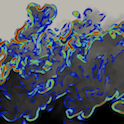The research within Reactive Flow Modeling Laboratory at UT is focused on addressing both fundamental and applied challenges in simulating complex reactive flow problems.
Our research efforts concentrate on both the development of accurate and computationally affordable algorithms, as well as on the application of existing algorithms to challenging reactive flow problems and configurations.
Current Projects
 We perform large scale Direct Numerical Simulations of canonical, laboratory-scale, lean methane/air turbulent premixed flames at 4 atm. The goal of the project is to investigate the effect of the Reynolds number of the flow on the statistics of the flame and flow field, including overall burning rates, surface densities, and local flame propagation characteristics.
We perform large scale Direct Numerical Simulations of canonical, laboratory-scale, lean methane/air turbulent premixed flames at 4 atm. The goal of the project is to investigate the effect of the Reynolds number of the flow on the statistics of the flame and flow field, including overall burning rates, surface densities, and local flame propagation characteristics.High-performance simulation of plasma discharges and plasma assisted ignition
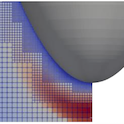 It is speculated that plasma discharges can be used to ignite very lean reactive mixtures, which may increase the energy efficiency and lower pollutants in combustion devices such as aircraft engines, gas turbines for power generation, and scramjets for high-speed flight. We developed and applied a novel computational framework for the large-scale simulation and analysis of those processes. As part of this project, we are developing a unique exascale parallel software based on the Adaptive Mesh Refinement library AMReX in collaboration with personnel at NREL. Funded by the National Science Foundation (Award #1903775) and the Department of Energy (Award DE-EE0008874).
It is speculated that plasma discharges can be used to ignite very lean reactive mixtures, which may increase the energy efficiency and lower pollutants in combustion devices such as aircraft engines, gas turbines for power generation, and scramjets for high-speed flight. We developed and applied a novel computational framework for the large-scale simulation and analysis of those processes. As part of this project, we are developing a unique exascale parallel software based on the Adaptive Mesh Refinement library AMReX in collaboration with personnel at NREL. Funded by the National Science Foundation (Award #1903775) and the Department of Energy (Award DE-EE0008874).Evolution of surfaces in turbulent flows
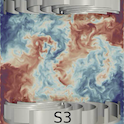 Turbulence stirs, folds, stretches, and wrinkles the interface separating gases, liquids, and fluids of different phases. Such process is ubiquitous in industry and environmental flows alike and governs the efficiency of many fundamental processes such as mixing, propulsion, cloud formation, and pollutant dispersion. We use large-scale simulations coupled with experiments by our collaborators at the University of Michigan in order to investigate the parameters that affect the rate at which the area of the interface increases as turbulence evolves. We aim to formulate general theories from numerical and physical experiments. Funded by the National Science Foundation (Award #1805921).
Turbulence stirs, folds, stretches, and wrinkles the interface separating gases, liquids, and fluids of different phases. Such process is ubiquitous in industry and environmental flows alike and governs the efficiency of many fundamental processes such as mixing, propulsion, cloud formation, and pollutant dispersion. We use large-scale simulations coupled with experiments by our collaborators at the University of Michigan in order to investigate the parameters that affect the rate at which the area of the interface increases as turbulence evolves. We aim to formulate general theories from numerical and physical experiments. Funded by the National Science Foundation (Award #1805921).Turbulent premixed combustion of carbon-free fuels
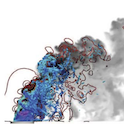 Carbon-free fuels such as ammonia and hydrogen offer an expedient route to decarbonization of electricity generation and, possibly, air transportation. Unfortunately, very little is known about the combustion characteristics of carbon-free fuels under turbulent combustion conditions. We started a project on the modeling of ammonia-hydrogen combustion in small combustors for power generation using large-eddy simulation. Funded by Ansaldo Energia under a partnership with King Abdullah University of Science and Technology (KAUST).
Carbon-free fuels such as ammonia and hydrogen offer an expedient route to decarbonization of electricity generation and, possibly, air transportation. Unfortunately, very little is known about the combustion characteristics of carbon-free fuels under turbulent combustion conditions. We started a project on the modeling of ammonia-hydrogen combustion in small combustors for power generation using large-eddy simulation. Funded by Ansaldo Energia under a partnership with King Abdullah University of Science and Technology (KAUST).Modeling of ablative materials for hypersonic vehicles
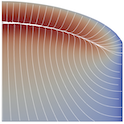 Ablative materials are considered a promising solution as thermal protection system (TPS) for hypersonic vehicles. When exposed to high heat fluxes due to hypersonic speeds, ablative heat shields decompose by way of pyrolysis reactions, thereby reducing the heat load on the underlying surfaces of the vehicle. The modeling of the performance of those materials is in its infancy and very few validated elementary physical models are available. We are developing modeling approaches that can be used to learn elementary physical parameters from experimental data. This research is also relevant to the design and operation of atmospheric-re-entry capsules and probes landing on planets.
Ablative materials are considered a promising solution as thermal protection system (TPS) for hypersonic vehicles. When exposed to high heat fluxes due to hypersonic speeds, ablative heat shields decompose by way of pyrolysis reactions, thereby reducing the heat load on the underlying surfaces of the vehicle. The modeling of the performance of those materials is in its infancy and very few validated elementary physical models are available. We are developing modeling approaches that can be used to learn elementary physical parameters from experimental data. This research is also relevant to the design and operation of atmospheric-re-entry capsules and probes landing on planets.Past and inactive Projects
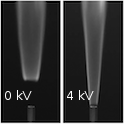 Electric fields have been shown to affect flame behavior and combustion properties by acting upon the charged particles produced naturally in flames. Among the positive effects are improvement of stabilization characteristics and reduction of pollutant emissions. In our group, we are developing models to characterize the ion and electron distribution in flames and to predict flame behavior under electric fields.
Electric fields have been shown to affect flame behavior and combustion properties by acting upon the charged particles produced naturally in flames. Among the positive effects are improvement of stabilization characteristics and reduction of pollutant emissions. In our group, we are developing models to characterize the ion and electron distribution in flames and to predict flame behavior under electric fields. The formation of particles from supersaturated vapor is a fundamental process in aerosol-laden flows, both in nature and in technological applications. In our group we investigate the coupling between the spatially inhomogeneous mixing field and the aerosol microphysical processes. We carry out complementary experimental and numerical research activities.
The formation of particles from supersaturated vapor is a fundamental process in aerosol-laden flows, both in nature and in technological applications. In our group we investigate the coupling between the spatially inhomogeneous mixing field and the aerosol microphysical processes. We carry out complementary experimental and numerical research activities.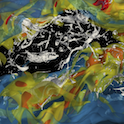 Soot emissions are an undesirable by-product of rich combustion in technical combustion devices. Our group uses direct numerical simulation (DNS) understand and mitigate soot formation in turbulent flames.
Soot emissions are an undesirable by-product of rich combustion in technical combustion devices. Our group uses direct numerical simulation (DNS) understand and mitigate soot formation in turbulent flames.
Simulation of tribrachial flames
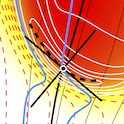 Tribrachial flames play a role in the stabilization and dynamics of laminar and turbulent flames and their propagation is relevant to the partially premixed combustion regime. We conduct detailed simulation of tribrachial flames of complex hydrocarbon fuels with state-of-the-art methods for reactive flows in the low Mach number limit.
Tribrachial flames play a role in the stabilization and dynamics of laminar and turbulent flames and their propagation is relevant to the partially premixed combustion regime. We conduct detailed simulation of tribrachial flames of complex hydrocarbon fuels with state-of-the-art methods for reactive flows in the low Mach number limit.
